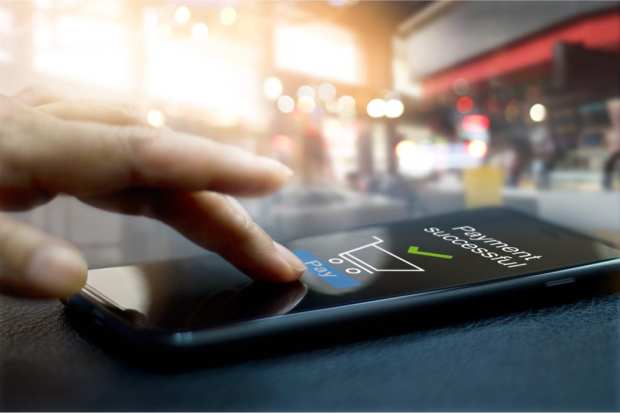Disbursements By Voice Are Growing In Popularity – And Other Instant Disbursements Trends

Consumers and microbusinesses now get an average of two disbursements each year, excluding tax disbursements from local, state and federal governments.
Yet, many of those disbursements are neither digital nor instant and available for consumers and microbusinesses to access and spend on demand, PYMNTS’ latest Disbursements Satisfactory Report found. The study surveyed more than 5,000 U.S. consumers and 500 microbusinesses that receive disbursements, as well as 600 companies of all sizes that make disbursements on payout options, instant payment adoption and fees for these services, among other topics.
Some business verticals are doing better than others, the PYMNTS study found. For instance, instant payments are most prevalent in the worlds of wages, insurance disbursements and lending payouts, according to the survey results. However, others underestimate the level of demand there is for receivers — consumers and microbusinesses — to be paid that way for use cases including invoice payments and other disbursement payments.
Here are five fast facts that PYMNTS’ study uncovered about demand for both a modern digital disbursements experience and the implications for businesses that do — and don’t — make them part of their payments strategy.
Fast Fact No. 1: Instant disbursements as a percentage of all non-tax disbursements in the U.S. are growing — but slowly.
More than two-thirds of consumers (68.1 percent) received at least one, non-tax disbursement in the past year, the vast majority of which were not instant. Among consumers, instant payments accounted for a little more than one in 10 of those disbursements (14 percent). Although that slice of the disbursement pie is small, that figure also shows growth in the segment. According to the data, that’s up from 12.8 percent in 2019 and 9.5 percent as of 2018.
And while adoption among consumers has been very gradual, adoption has been even slower among microbusinesses, according to the report, with the adoption rate for such disbursements among these businesses only at about 8 percent as of 2020.
Fast Fact No. 2: Payors think they offer receivers a choice for how they want to receive a payment. Consumers disagree.
The PYMNTS study found that 79 percent of payors said they offer payment choice when it comes to disbursements related to insurance and loan payouts. However, only 51 percent of receivers said they were offered a payment choice for insurance- and lending-related payouts.
That gap stems from several sources. Consumers might not recognize similar payment options as distinct from each other, like standard ACH and same-day ACH. Both deposit money into their bank accounts, even though they take different amounts of time for funds to made available.
The other explanation is that the options are choices that consumers find unacceptable so don’t regard them as a choice.
Fast Fact No. 3: Instant disbursements have the potential to make or break consumer or business loyalty.
The PYMNTS study found that 61 percent of consumers and 67 percent of microbusinesses are at least somewhat more likely to continue doing business with firms that offer fee-free instant payments. That compares to nearly 30 percent who reported being likely to do business with companies where disbursement options didn’t include free instant payments as a choice.
The data also demonstrated that payors tend to underestimate the instant payments demand in the market, believing that more than two-thirds of their payees will continue working with them in the absence of instant payment offerings.
Fast Fact No. 4: Receivers value instant payouts enough that they are willing to pay to get paid that way.
According to PYMNTS data, just 17.3 percent of consumers and 14.8 percent of microbusinesses are willing to pay a fee to receive funds instantly. Context, however, does matter. When it comes to receiving an insurance disbursement or receiving funds they’d borrowed, for example, some 30.9 percent (roughly double what was observed in other categories) expressed a willingness to pay an additional fee for instant payment, even though current regulations preclude payors from charging fees for those payouts.
Payors on the other hand seem open to the idea of covering the fees, according to PYMNTS data, At least 63 percent of payors would be at least “very likely” to pay fees to make instant payments available to their payees. The question is, however, how long it will take for them to do that.
Fast Fact No. 5: ‘Disbursements by Voice’ are growing in popularity.
PYMNTS research revealed significant interest in being able to control their payout options using voice commands. Many payees want to use voice to direct disbursements to preferred bank accounts, credit cards, debit cards or digital wallets.
In fact, 27 percent of consumers reported that they’d be more likely to carry on a business relationship with payors who offered voice as an option for directing disbursements to a preferred location (bank account, card, etc.). One quarter of consumers would be more likely to continue relationships with payors who made it possible to use voice commands to direct their money however they needed or wanted.
But as is often the case in the world of voice, those figures go up when one zooms in on a younger demographic, like “bridge millennials” (those between the ages of 32 and 41). In that demographic, 37 percent would be more likely to continue business relationships with companies that offered voice capabilities to direct funds however they pleased. Similarly, 37 percent said the same about being able to direct disbursements to preferred bank or card accounts.
